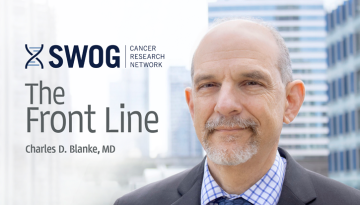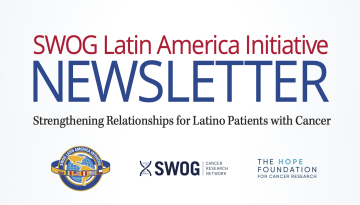December Means San Antonio -- and ASH
December closes with a couple of the year's biggest holidays, but it also opens with a couple of the year's biggest professional meetings for those of us involved in clinical oncology research – the San Antonio Breast Cancer Symposium (SABCS) and the American Society of Hematology (ASH) Annual Meeting and Exposition (to give it its proper title).
Here are a few SWOG highlights, presented at these two meetings:
- At SABCS, Dawn Hershman, MD, our group co-chair-elect, presented a new risk model that uses baseline sociodemographic and financial measures to predict which patients with breast cancer are at significantly higher risk of non-adherence to long-term aromatase inhibitor (AI) therapy. Working with data from SWOG S1105, which had tested a text-messaging intervention for improving AI adherence, Dr. Hershman and her colleagues found four baseline measures had statistically significant associations with increased non-adherence to AI therapy: younger age, not having a college education, lower out-of-pocket prescription costs, and living in urban areas. They also found that race and ethnicity were not associated with non-adherence in their S1105 data. The authors say that predicting who is most at risk of non-adherence early in the treatment cycle can allow us to target personalized interventions to the right patients. You can learn more about these findings in our press release.
- SWOG S1318 enrolled patients age 65 or older with acute lymphoblastic leukemia (ALL), including a cohort with Philadelphia chromosome-positive (Ph+) disease. Older patients with Ph+ ALL are often not good candidates for the intensive chemotherapy typically used in treating this disease, so S1318 tested an alternate regimen of dasatinib, blinatumomab, and prednisone in these patients. At a previous ASH meeting, Anjali S. Advani, MD, S1318 study chair, delivered initial positive results from this cohort. This month she presented long-term follow-up data that confirmed the durability of those promising early findings – patients on this alternate regimen had a median overall survival of 6.5 years. Details of the results are available in our press release and in the abstract.
- S1826 results initially presented at ASCO this summer gave us the headline that would change practice: in patients with advanced-stage classic Hodgkin lymphoma, a combination of nivolumab plus AVD chemo (N-AVD) halved the risk of progression or death in the first year after treatment, as compared to standard-of-care Bv-AVD (brentuximab vedotin plus Adriamycin, vinblastine, and dacarbazine). One of the most innovative aspects of this study was that it enrolled patients across the age spectrum – from 12 through 83 years (in part thanks to unprecedented collaboration with the Children’s Oncology Group). Two oral presentations at ASH 2023 have now reported results from S1826 patients at either end of that spectrum.
- About one-quarter of enrolled patients were under the age of 18. Kara Kelly, MD, reported that in this pediatric cohort, 1-year progression-free survival (PFS) on the N-AVD arm was 94 percent compared to 88 percent on the Bv-AVD arm. The rate of grade 3+ hematologic adverse events in pediatric patients was similar across the arms, and overall rates of immune-related adverse events were low on both arms. The rate of discontinued treatment among pediatric patients, however, was somewhat higher in the N-AVD arm: 8.3 percent vs. 2.6 percent. This contrasted with what was seen among adults (7.9 percent vs. 21.1 percent). The authors conclude “S1826 is a model NCTN trial, providing earlier access to novel agents and harmonization of treatment for adolescents and young adults with AS cHL,” though, they say, longer-term follow-up is needed to define the role of N-AVD in this population. Read the abstract.
- ASH 2023’s second oral presentation on S1826, by Sarah Rutherford, MD, reviewed outcomes in the trial’s 97 patients age 60 and older. Among these patients, 1-year PFS was 93 percent (N-AVD) vs. 64 percent (Bv-AVD). Treatment discontinuation rates on the N-AVD arm were roughly one-third those on the Bv-AVD arm, and the difference in the non-relapse mortality rate was 4 percent (N-AVD) vs. 14 percent (Bv-AVD). The authors conclude “N-AVD is poised to become a standard of care for older AS HL pts fit for anthracycline-based combination therapy.” Read the abstract.
- The corticosteroid dexamethasone (dex) is a common component of induction therapy regimens for multiple myeloma, but the significant toxicities that can come with it often lead to dose reductions during that treatment. Rahul Banerjee, MD, gave an oral presentation at ASH of a secondary analysis of data from two studies SWOG conducted in patients with newly diagnosed multiple myeloma treated with dex: S0777 and S1211. Of the more than 500 patients whose data Banerjee and his coauthors analyzed, 76 percent had had their dex dose lowered – in some cases by more than half – as they moved through induction therapy. The researchers analyzed the impact of those dex reductions on patient outcomes. They found that progression-free survival and overall survival in dose-reduced patients were comparable to those in patients who had received the full dose. This held even in the subset of patients whose dose had been cut by 50 percent or more. The results have given quite a boost to the #DownWithDex movement on Twitter. Read the abstract.
I don’t have room here to review all of this month’s presentations of SWOG research results, so I’ll close this summary of recent meetings with a nod to the biggest meeting on our calendar – ASCO!
ASCO’s submission deadline is February 6th, but SWOG’s ASCO deadline is Tuesday, January 23. Get your abstracts (including TIPs and LBA placeholders) to Pat Arlauskas, our publications manager (pubs@swog.org), by that date if you want them submitted before ASCO’s deadline. And in June, I may be writing about your research in this space.
Other Recent Stories



